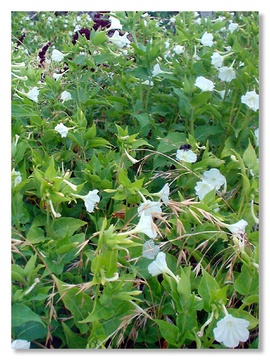 Left to their own devices, Four o'Clocks will reproduce like rabbits!
Left to their own devices, Four o'Clocks will reproduce like rabbits!
Four o'Clocks (Mirabilis spp.) are leafy, multi-branched perennials of the tobacco (Nyctaginaceae) family that produce flowers throughout the summer months, and are so named because they open in the evening, ostensibly around 4pm, only to close by morning.
There are seven species of four o-clocks that are native to California, but none are native to Davis or to Yolo County. Some, such as the Desert Wishbone Bush (Mirabilis laevis) can be successfully grown in Davis gardens.
Marvel of Peru (Mirabilis jalapa) is one commonly grown non-native four o'clock species of controversial origin: it may originate from Mexico, Chile, or India. Other names for this favorite of moths include Bonita, Beauty of the Night, Buenas Tardes, and Morning Rose. Indigenous peoples throughout South America use the root as a hallucinogen and a myriad of other medicinal purposes while the flowers are used for dyes. In the US, Mirabilis is used for mumps, bone fractures, and as an uterine stimulant. There is a low amount of toxicity involved in handling the roots and seeds of this plant. The flower itself is used for dyes, and thus does not seem to cause irritation and internal problems! 1
Mature plants can grow to almost three feet in height and spread. They have opposite, pointed leaves 2-4 inches long and fragrant flowers borne singly or in clusters, ranging from white or yellow to various shades of red. Each flower is trumpet shaped, about an inch across at the end and about two inches long. Though typically grown from seed, Marvel of Peru develops large, carrot-shaped tubers that can grow to a foot or more in length.
Marvel of Peru is easy to grow, developing rapidly and thriving in most any soil; it does equally well in sun or deep shade, is somewhat drought tolerant, and self seeds freely. These properties make it a welcome addition to shade gardens in need of color. In Davis, these hardy perennials require no overwintering protection to return each spring. Their large seeds and tubers make propagation & transplanting simple, and easy identification of large seedlings helps weed out unwanted starts in the spring.
For a listing of other plants found growing in Davis, visit our Town Flora.
Footnotes
1. "Poisonous Plants of North Carolina", http://www.ces.ncsu.edu/depts/hort/consumer/poison/Mirabja.htm



